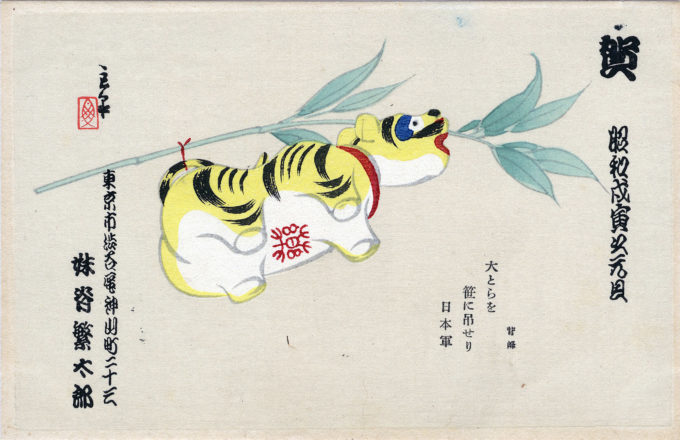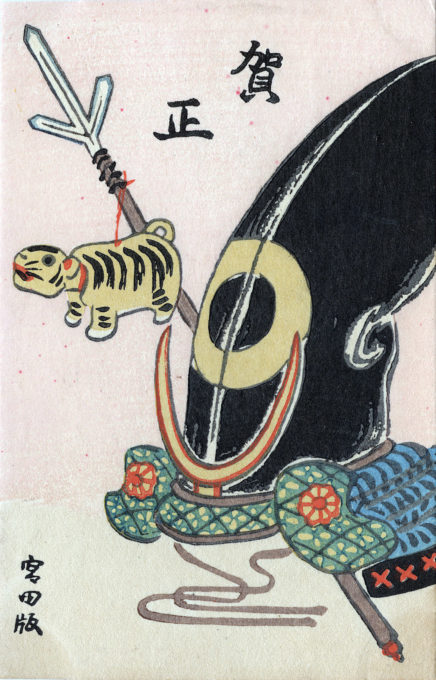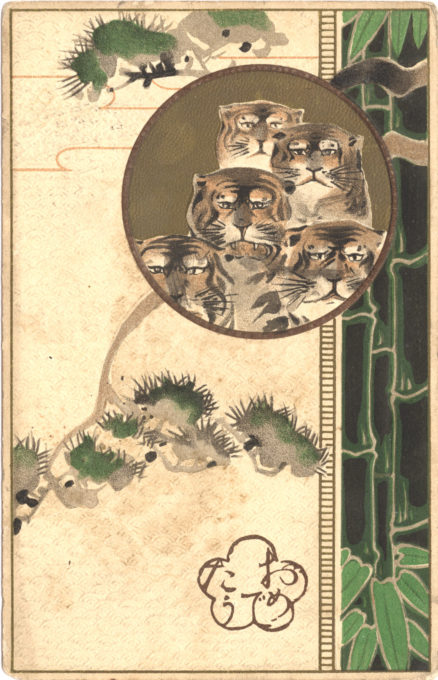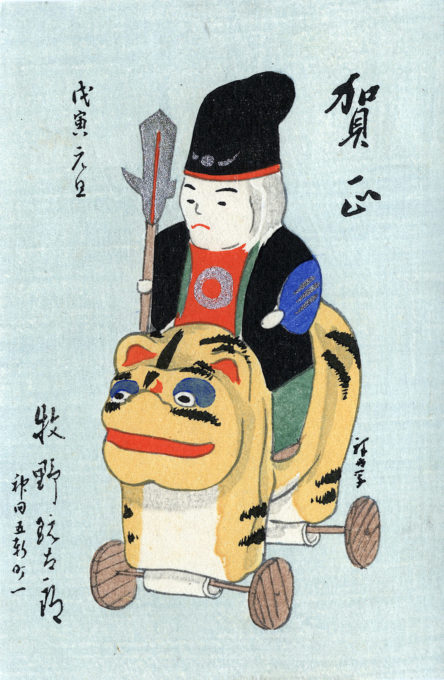
“Year of the Tiger”, New Year’s postcard, 1938. A bobble-headed hariko (a traditional papier-mâché folk art) dangling from a branch of bamboo, with the traditional kanji for “medicine” [藥] affixed to its stomach. Even though the tiger (tora) is not native to Japan, it figures prominently in Japanese culture and arts, represented everywhere from first appearing in classic 8th-century literature (Nihon Shoki) to becoming a distinctive style of kabuki stage makeup to sports (the Osaka Tigers baseball team) to being the coded message transmitted back to Admiral Yamamoto’s flagship of the success of surprise at the onset of the Pearl Harbor attack (“Tora! Tora! Tora!”).
“Imperial Year 2598 [1938] is the Year of the Tiger.
“The dauntless tiger [tora] crosses one thousand leagues, fearful of nothing. It is said he topples all enemies. Thanks to our incomparably brave troops, ferocious like the tiger, an eternal peace is being established in Asia.
“We wish military success and long life to those troops who are being deployed this spring. Like the masterful tiger, Japan’s troops subject time and disorder to their righteous control as they cross the vast territories of China.”
– Japanese government propaganda handbill, 1938

“Year of the Tiger”, New Year’s postcard, 1938. A bobble-headed hariko of a tiger (tora) dangles in front of a lacquered eboshi-nari kabuto (court cap-shaped helmet), formal samurai headgear since ancient times.
“Like the lion, the tiger is a stranger to the Japanese islands, and was usually portrayed in the traditional manner imported from China via scroll paintings.
“Year of the Tiger”, New Year’s postcard, 1914, depicted in a traditional Chinese-brush style painting. Historically, feudal military leaders included the character for tiger in their names to such an extent that koga [虎牙, “tiger’s fang”] became synonymous with ‘general’ [shogun].
“It was long assumed to be a mythical beast and is the symbol of courage. It is said to live a thousand years. When it reaches the age of five hundred, a character meaning ‘king’ is said to appear on its head, and at the age of a thousand, it becomes an inhabitant of the Milky Way.
“The tiger is the animal symbol for the third year of the Japanese zodiac. In Oriental symbology, there has long been a conventional connection between the tiger and bamboo. The tiger is often shown forcing its way through the thick undergrowth of the jungle, thus symbolizing ‘Will’ overcoming ‘Evil’.
“When a tiger is shown crouching beside a clump of bamboo in a storm, the tiger is a symbol of the power of faith. And it took quite a lot of faith for the Japanese to believe in the images of tigers, since tigers are not native to Japan.”
– Netsuke Japanese Life and Legend in Miniature, by Edwin C. Symmes, Jr., 2013
1902, 1914, 1926, 1938, 1950, 1962, 1974, 1986, 1998, 2010, 2022
“People born in the Year of the Tiger are creative, independent, active, and courageous. They make natural leaders, as they can stimulate and inspire ohers. They’re unconvential and can be rash, impetuous, and outspoken.
“The Tiger is most compatible with the Pig and least compatible with the Monkey.
“The Year of the Tiger is a turbulent year full of surprises and unexpected developments. You need to be cautious in everything you do.”
– Llewellyn’s Complete Book of Divination, by Richard Webster, 2017



